Best Dog Wheelchairs — Help Your Dog Walk and Play Again!
Is your dog having trouble walking? Do their legs feel weak or wobbly? It can be very sad to see your best friend struggle to stand, run, or play. But don’t worry — there is a way to help them feel happy again!
The Best Dog Wheelchairs are like magic wheels that help dogs walk when their legs can’t. They give your dog back the fun of walking, playing, and moving around.
In this easy guide, I will show you:
- When your dog might need a wheelchair
- What kind of wheelchair is best for your dog
- How it can make your dog happy and active again
Let’s help your dog get their smile back!
Why Your Dog Might Need a Wheelchair
A dog wheelchair is a simple device that helps dogs walk when their legs can’t keep up. It gives them back the freedom to move, play, and enjoy life.
If your dog is struggling to walk, getting weak in the legs, or losing balance, a wheelchair might be what they need.
When Should You Consider a Wheelchair for Your Dog?
1. Back Legs Are Getting Weak
- They drag their paws.
- Trouble standing after resting.
- Wobbly or shaky when walking.
2. Needs Help with Balance Sometimes
- Slips on smooth floors.
- Can’t manage stairs or uneven ground.
- You often find yourself lifting their back end.
3. Not as Active or Playful
- Stops playing fetch.
- Sleeps more, avoids walks.
- Hesitates to jump on the couch or bed.
4. Tires Out on Short Walks
- Walks used to be long and fun.
- Now they stop and want to go home early.
- You notice their legs shake after exercise.
Specific Health Problems Where a Wheelchair Can Help
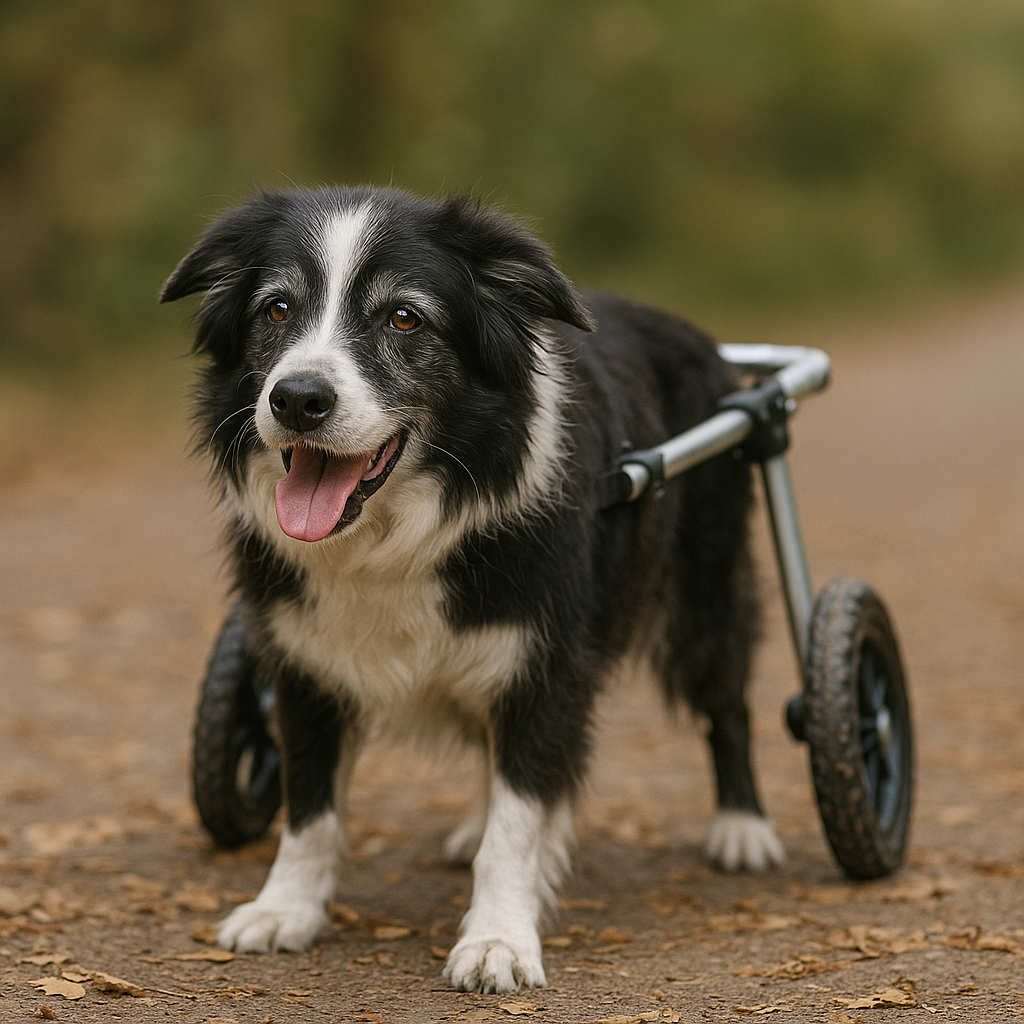
Intervertebral Disc Disease (IVDD)
This is a spinal problem. The discs press on the nerves, making it hard for your dog to walk. A dog wheelchair can give them the support they need while they heal.If surgery isn’t possible, a wheelchair can still help them stay mobile.
Degenerative Myelopathy (DM)
DM is a disease that affects older dogs.
It starts with weakness in the back legs. Over time, walking becomes harder.
Using a rear support cart early can keep your dog active for longer.
Arthritis and Hip Dysplasia
These are painful joint problems. Your dog may stiffen up and struggle to move.
A canine mobility aid like a wheelchair takes the weight off sore joints.
This makes walking easier and more comfortable.
Sudden Paralysis
An accident or medical condition like an FCE (stroke-like event) can suddenly paralyze your dog’s legs.
A dog wheelchair reduces pressure on painful joints, allowing dogs to stay mobile and enjoy their daily activities.
Knee and ACL Injuries
After surgery, your dog might need help walking.
A dog rehab cart supports their legs and protects the healing joints.
It helps them recover safely and stay active.
👉 For more detailed info, check out our guide on Dog Wheelchair for Specific Health Conditions.
We explain which type of wheelchair suits IVDD, arthritis, DM, and other conditions best.
Dog Wheelchair Types Which One is Right for Your Pet?
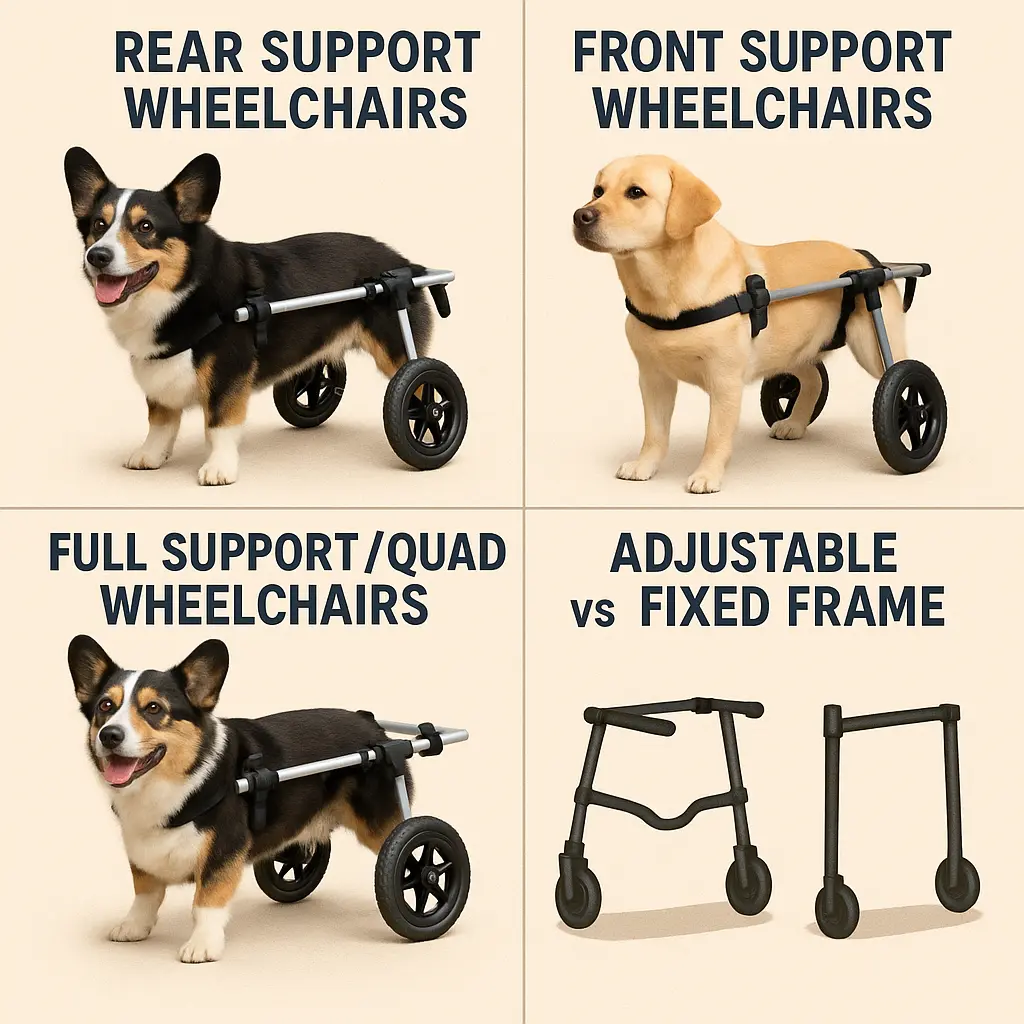
Choosing a dog wheelchair feels overwhelming. I’ve been there. When my dog Max lost strength in his back legs, I had no clue which type was right. But after lots of research (and a few mistakes), I learned it’s not as confusing as it seems.
Let me walk you through it, just like I wish someone had done for me.
Rear Support Wheelchairs (Hind Leg Paralysis, Weakness)
These are the most common type. Rear wheelchairs help dogs who have weak or paralyzed back legs. Think of it like giving your dog a set of wheels where their legs can’t carry them anymore.
Max used a rear support cart when his arthritis got worse. His back legs couldn’t hold him up, but with the wheels, he was running again. It was magical.
You should consider this if:
- Your dog drags their back legs.
- They wobble or fall often.
- Standing up seems like a big effort.
Front Support Wheelchairs (Front Leg Injuries or Deformities)
Front support wheelchairs are less common but super helpful for dogs with front leg problems. If your dog had an injury, deformity, or a birth defect affecting the front legs, this is what they need.
I met a sweet Corgi named Daisy who was born with deformed front legs. Her owner got her a front support cart. The joy on her face when she finally moved freely was unforgettable.
You should look into this if:
- Your dog limps or struggles to use the front legs.
Full Support / Quad Wheelchairs (Spinal Injury, Neurological Issues)
These are the heavy lifters. Full support (or quad wheelchairs) support all four legs. They’re perfect for dogs who lose balance everywhere — not just in the back or front.
These carts are lifesavers for dogs with:
- Spinal injuries.
- Neurological diseases like Degenerative Myelopathy.
- General weakness due to age.
It’s like giving your dog a walking frame but cooler — and with wheels!
Adjustable vs Fixed Frame: What’s Better for Long-Term Use?
Let’s talk frames.
Adjustable wheelchairs grow with your dog. They’re flexible, easy to tweak, and perfect if your dog’s condition might change over time. I loved that we could adjust Max’s Walkin’ Wheels as his strength changed.
Fixed frame wheelchairs are custom-made. They’re sturdy, lighter, and perfect for long-term, stable conditions. But they don’t offer room for adjustments if your dog’s needs evolve.
Here’s a simple way to decide:
- If your dog’s condition is progressive (like DM or arthritis), go adjustable.
- If the injury is permanent and stable, fixed might be better.
Key Takeaways 📝
- Rear wheelchairs are for back leg weakness.
- Front wheelchairs help dogs with front leg injuries.
- Full support carts are for total balance problems.
- Adjustable frames are flexible for changing needs.
- Fixed frames are lighter but custom-fit.
How to Choose the Right Dog Wheelchair for Your Pet

Picking the perfect dog wheelchair can feel tricky. I remember standing in front of my computer, feeling lost. Rear support? Quad? Foam wheels?
But once you break it down, it’s not that hard.
Let’s make it simple.
Rear Support vs Front Support vs Quad Wheelchairs
- Rear Support Wheelchairs
These are for dogs who have weak or paralyzed back legs. My dog Max used one when his arthritis made walking tough. It lifted his back legs, giving him the freedom to move again. - Front Support Wheelchairs
If your dog has front leg injuries or was born with deformities, a front support cart is the way to go. It helps balance their weight and supports their chest. - Quad (Full Support) Wheelchairs
These are for dogs who need help with all four legs. Dogs with spinal injuries or diseases like Degenerative Myelopathy often need this type.
Pro Tip:
Watch how your dog moves. If the back legs are the only issue, go rear support. If balance is the main problem, think quad.
Adjustable Frame vs Fixed Frame
- Adjustable Frames
These are flexible and grow with your dog. You can tweak the height, length, and width. They’re perfect if your dog’s condition might change over time. - Fixed Frames
Custom-made for your dog’s size and shape. They’re lighter and more compact but don’t allow adjustments later.
I chose an adjustable frame for Max because his needs kept changing. But if your dog’s injury is permanent and stable, a fixed frame might feel better for long-term comfort.
Foam Wheels vs Air Tires
- Foam Wheels
Solid, durable, and maintenance-free. Best for indoor use or smooth pavements. No risk of punctures. - Air Tires
Soft and bouncy. Great for outdoor adventures, rough terrain, or sand. They do need some care (like filling air), but they give a smoother ride.
Think about where your dog loves to walk. Smooth city sidewalks? Foam wheels will do. Rough trails or beaches? Go for air tires.
Factors to Consider Before Buying
Here’s what I learned while choosing Max’s wheelchair:
- Weight Limit
Make sure the wheelchair supports your dog’s weight comfortably. - Terrain Use
Do you walk in parks, city streets, or sandy beaches? Pick wheels and frames that fit your lifestyle. - Your Vet’s Advice
Always talk to your vet. They’ll guide you on what support level your dog needs. - Ease of Use
Is it easy to put on and take off? Trust me, this makes a huge difference in daily life. - Adjustability
If your dog’s health might change, an adjustable wheelchair gives you more control.
Want a Full Buying Checklist?
Check out our complete Dog Wheelchair Buying Guide.
It covers sizing charts, brands, and expert tips to help you choose with confidence.
Dog Wheelchair Size Chart — Find the Perfect Fit
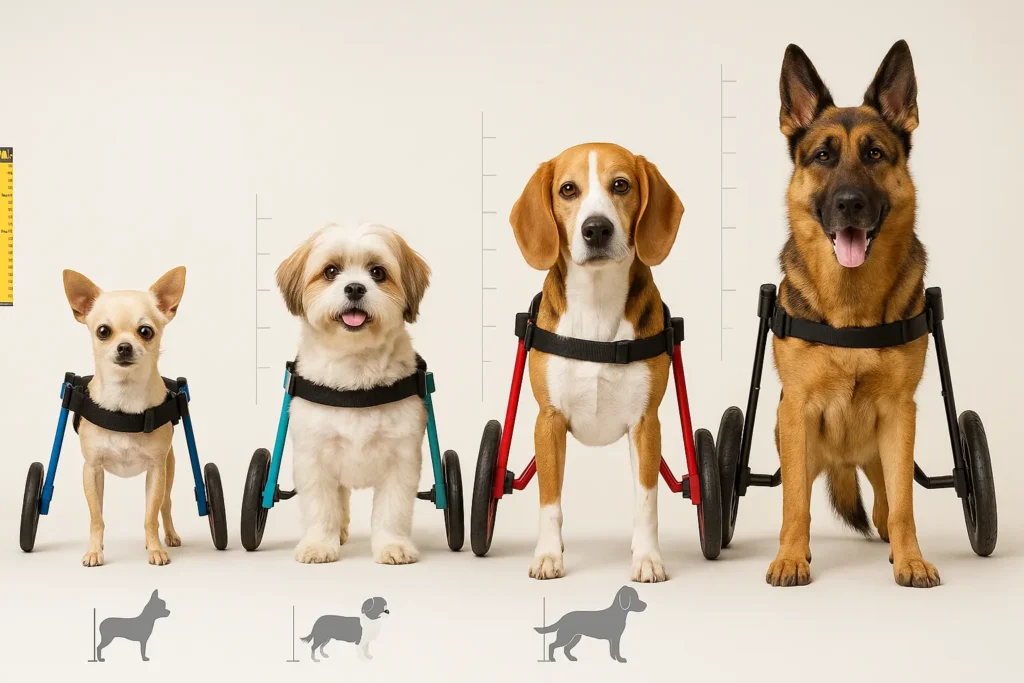
Getting the right size wheelchair for your dog is more important than you think.
A well-fitted wheelchair means your dog can walk, run, and play safely.
A bad fit? It could cause more harm than good.
But don’t worry! I’m here to guide you step-by-step.
Size Selection by Dog’s Weight (Mini, Small, Medium, Large)
The easiest way to start is by looking at your dog’s weight.
Most dog wheelchairs come in these four size ranges:
| Size | Dog Weight (Approx.) | Example Breeds |
| Mini | Under 10 lbs | Chihuahua, Toy Poodle |
| Small | 10–25 lbs | Shih Tzu, Pomeranian |
| Medium | 25–60 lbs | Cocker Spaniel, Beagle |
| Large | Over 60 lbs | Labrador, German Shepherd |
👉 Pro Tip: Always check the brand’s specific weight chart.
Brands like Walkin’ Wheels and K9 Carts may have slight differences.
How to Measure Your Dog’s Rear Leg Height
Weight is a good start, but leg height is crucial for a proper fit.
This is where many pet parents (including me) go wrong the first time.
Here’s How You Measure Rear Leg Height:
- Have your dog stand as straight as possible.
- Use a soft tape measure.
- Measure from the ground up to the top of the thigh (where the leg meets the body).
- Write this number down. You’ll need it when choosing frame size.
Need more help?
Check out our full guide on How to Measure a Dog for a Wheelchair.
It has photos and tips that make measuring easy.
Adjustable Frame vs Fixed Frame: Which One Should You Choose?
When I was buying Max’s wheelchair, I had this exact question.
Adjustable Frames:
- They grow with your dog.
- You can tweak height, length, and width.
- Great if your dog’s condition is changing (like arthritis or DM).
Fixed Frames:
- Custom-made to fit your dog perfectly.
- Lighter and more streamlined.
- Best for stable conditions that won’t change.
Common Sizing Mistakes to Avoid
I made these mistakes so you don’t have to.
- Guessing Leg Height
Eyeballing isn’t good enough. Always measure. - Ignoring Weight Limits
A lightweight frame won’t support a large dog.
Check weight capacity for safety. - Not Considering Terrain
If you walk on rough ground, you might need air tires.
Foam wheels are fine for smooth pavements. - Skipping Vet Advice
Your vet knows your dog’s condition best.
Ask them what level of support is needed.
Key Takeaways
- Start with weight, but leg height is key.
- Adjustable frames are flexible for changing conditions.
- Fixed frames are lighter but custom-fit.
- Always measure correctly and check weight limits.
- When in doubt, consult your vet or check sizing guides.
Need More Help?
Choosing the right size can feel tricky, but you’re not alone.
If you need a step-by-step visual, don’t miss our full How to Measure a Dog for a Wheelchair guide.
Accessories You’ll Need with a Dog Wheelchair
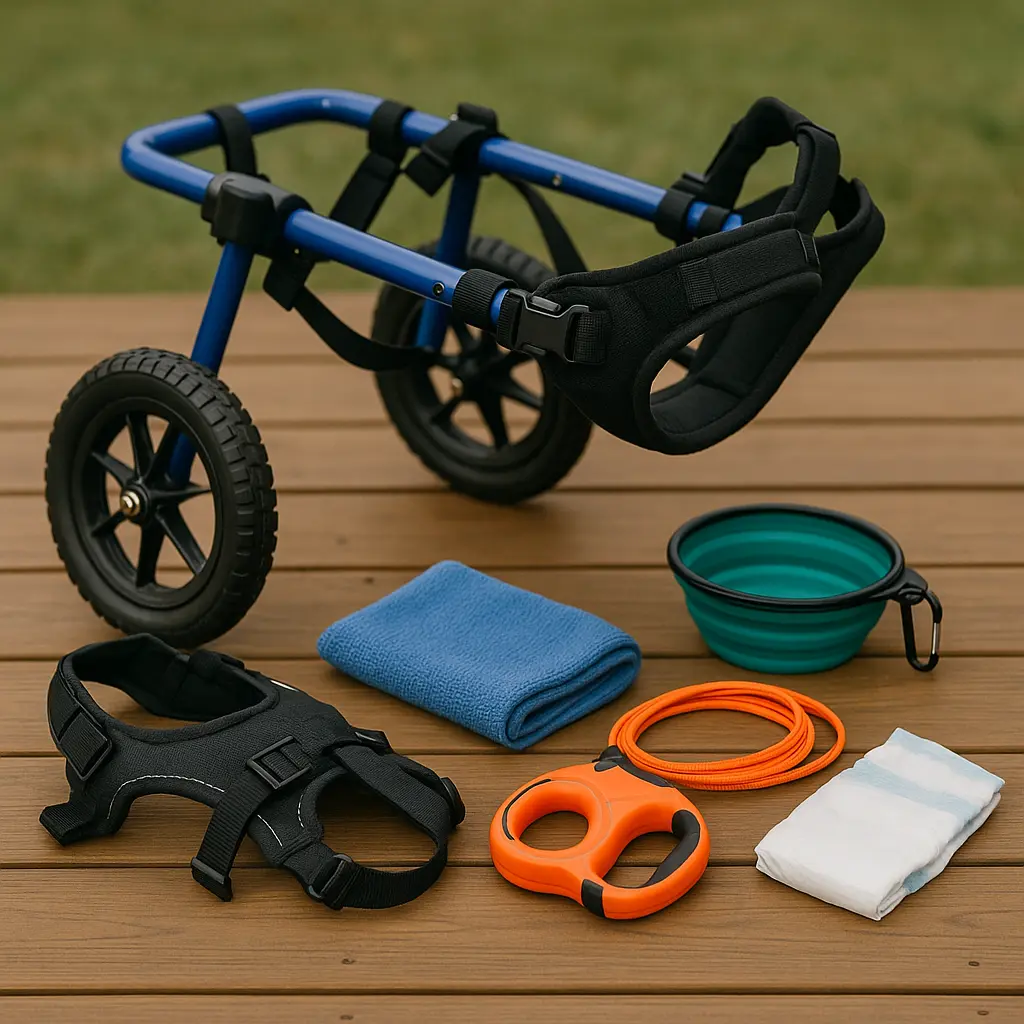
When my dog Max first got his wheelchair, I thought we had everything we needed. But I quickly learned accessories make life easier—for both dogs and pet parents.
Here are some must-have extras you’ll want from day one.
Comfort Harnesses
A comfortable harness is a lifesaver. It reduces rubbing and makes your dog feel secure. Look for soft, padded harnesses made specifically for wheelchairs.
Rear Leg Slings
These are great when your dog needs extra help getting in and out of the wheelchair. A rear sling supports their back legs, helping them move gently and safely.
Booties or Paw Protectors
Dog booties aren’t just cute—they protect paws from scrapes or dragging injuries. If your dog drags their paws, protective boots are essential.
Replacement Wheels (Foam or Air Tires)
Having an extra set of wheels is always helpful. Foam wheels are best for smooth surfaces, while air tires handle rough terrain easily.
Wheelchair Carrying Bag
A sturdy bag keeps everything organized—perfect for traveling or quick visits to the park.
Want even more ideas? Check out our full guide on Dog Wheelchair Accessories & Add-Ons to see photos, recommendations, and helpful tips.
Can Dogs Pee & Poop in a Wheelchair? (Hygiene Tips)
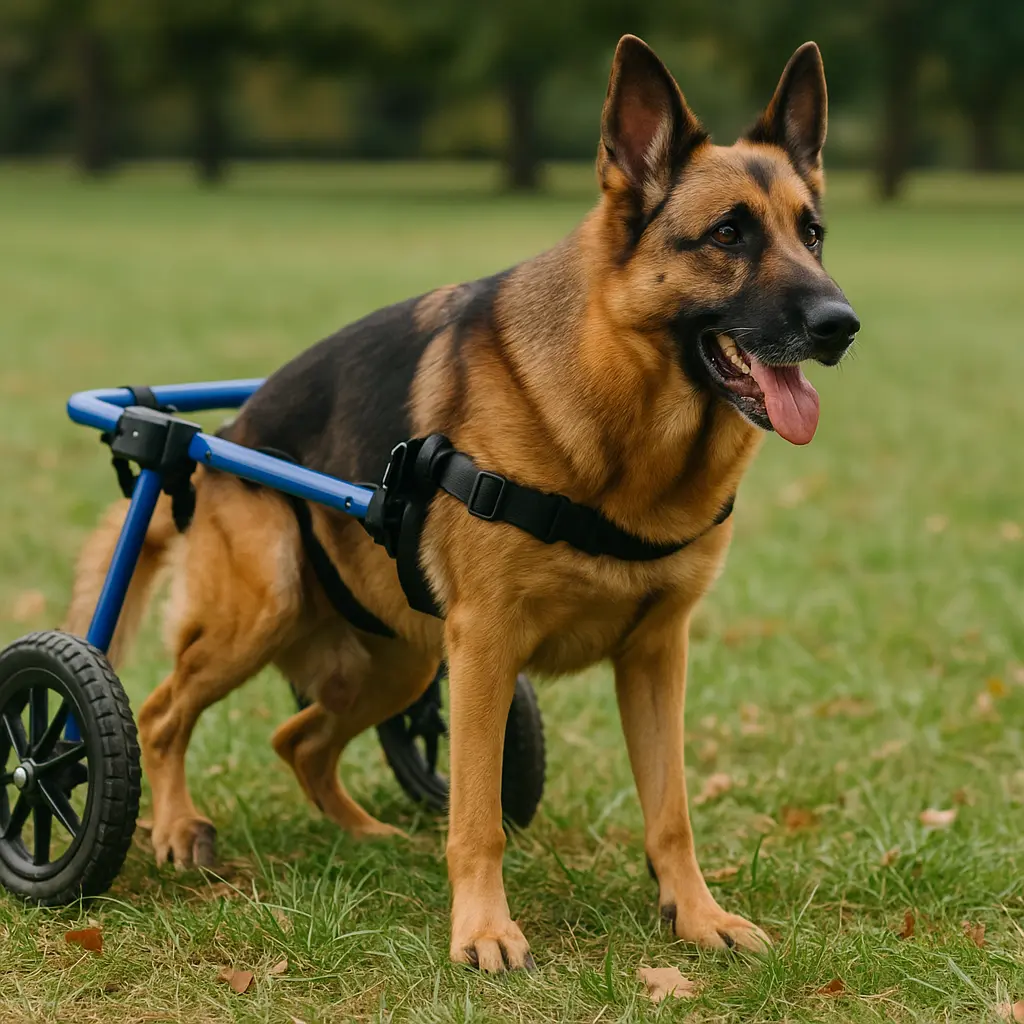
When Max first got his dog wheelchair, this was my biggest worry. Could he still pee and poop easily? Would things get messy? I had no clue.
Good news: dogs can absolutely go potty while using a wheelchair!
But it takes a little care to keep things clean and simple.
Let me share what I learned to make life easy for both you and your pup.
Can Dogs Really Go Potty in a Wheelchair?
Yes, they can—and very easily! Dog wheelchairs are designed to let your dog pee and poop without trouble.
Your dog’s back legs stay supported, leaving enough space for them to go potty comfortably.
At first, Max seemed unsure. But after a couple of tries, he realized he could still do his business naturally. Trust me—dogs adapt faster than we think.
Tips to Keep Things Clean and Easy:
Here are some simple things I did to keep Max clean and comfortable:
1. Take Regular Potty Breaks
- Keep breaks frequent, about every two to three hours.
- A regular schedule helps your dog avoid accidents in their wheelchair.
2. Use Washable Pads or Diapers
- For dogs who might leak or have accidents, washable diapers help a lot.
- Pads are easy to wash and make cleanup fast.
3. Check and Clean After Every Walk
- Check your dog’s belly and legs quickly after each use.
- Keep baby wipes handy to easily clean any mess.
4. Choose a Wheelchair with Easy-to-Clean Parts
- Brands like Walkin’ Wheels and K9 Carts have simple designs you can clean quickly.
- Smooth, washable surfaces help you stay stress-free.
Hygiene Tips from Personal Experience:
Max had arthritis and struggled to hold his potty at times. Using diapers saved our carpets many times! But diapers aren’t for every dog—some pups just hate them.
If your dog doesn’t like diapers, try washable mats instead. Place these mats where your dog rests most often. It’s simple and saves a ton of cleaning time.
Common Mistakes to Avoid:
I learned these the hard way, so you don’t have to:
- Waiting Too Long Between Potty Breaks:
Frequent breaks prevent messes. - Using Harsh Cleaners:
Stick to gentle soap or pet-safe wipes. Harsh chemicals can irritate sensitive skin. - Ignoring Small Leaks:
Small messes add up. Clean quickly to avoid bigger problems later.
Final Thoughts & Encouragement:
A wheelchair gave Max his freedom back. But it also meant learning new ways to handle daily care.
Remember—mistakes happen. Don’t feel bad if accidents occur. We all learn as we go. The important thing is giving your dog the comfort and happiness they deserve.
Have you faced similar issues? Or have other tips to share?
I’d love to hear your story or answer any questions you have. Let me know in the comments below!
Here’s your detailed, engaging, and easy-to-read blog post:
Training Your Dog to Use a Wheelchair Successfully

When Max first got his wheelchair, I thought training him would be tough. Would he accept it? Would he learn quickly? Or would it scare him? Luckily, it turned out much easier than I imagined.
Let me share some easy, practical tips from my experience that will help you train your dog to use a wheelchair with success.
Start Slow and Be Patient
Dogs need time to get used to new things. Imagine yourself using crutches for the first time—it feels strange, right? It’s the same for your dog. So take things slow and let your dog adjust gently.
Here’s what helped Max:
- Introduce the wheelchair in a calm place.
- Let your dog sniff and inspect it first.
- Offer treats while your dog checks out the wheelchair.
Keep the Sessions Short
Max would get tired or frustrated after a few minutes at first. I learned that short sessions were key. Five to ten minutes a few times a day worked best. Short training sessions help your dog stay calm and relaxed.
- Start with five-minute sessions.
- Gradually add a few minutes each day.
- Always end on a positive note with praise and treats.
Reward and Encourage Constantly
Treats, praise, and lots of petting are your best tools. Positive reinforcement works wonders. Max learned quickly when I gave him treats and affection.
Try this simple reward system:
- Small treats for every small success.
- Lots of praise for every effort.
- Use their favorite toys as rewards.
Practice in Safe and Familiar Places
Start indoors or in your backyard. Familiar places make your dog feel safe. Avoid busy areas or uneven ground at first. As Max got confident, we slowly tried new places.
- First, practice at home.
- Then, move to quiet parks or familiar sidewalks.
- Finally, explore new paths once your dog feels confident.
Troubleshooting Common Issues
At first, Max would just freeze. He stood still and stared at me, confused. Here’s how I helped him:
- If your dog won’t move: Encourage gently with treats. Move just a step or two ahead and call them warmly.
- If your dog seems scared: Stop the session, take off the wheelchair, and comfort them. Try again later.
- If your dog tips or stumbles: Adjust the wheelchair fit carefully. Make sure the wheels are even and the harness is comfortable.
Hygiene Tips During Training
Your dog might feel unsure about potty breaks in the wheelchair at first. That’s normal. I kept puppy pads and wipes handy until Max felt comfortable.
- Take potty breaks right before and after training.
- Use pads or diapers if needed during training.
- Keep wipes nearby for quick clean-ups.
Celebrate Small Wins
Every small step counts. The first time Max moved forward a few steps, I celebrated like he won a marathon! Dogs feel your excitement, so celebrate each small victory.
- Be genuinely enthusiastic when they succeed.
- Share affection freely.
- Let them feel proud of themselves.
Need a Detailed Training Plan?
Training your dog to use their wheelchair doesn’t have to be stressful. For more detailed steps, check our complete Training Guide for Dogs Using Wheelchairs. It’s packed with photos, videos, and step-by-step tips.
FAQs on Dog Wheelchair Training
How long does it take for a dog to get used to a wheelchair?
Can older dogs still learn to use a wheelchair?
My dog seems scared. Should I give up?
Can dogs use wheelchairs indoors?
Should I leave the wheelchair on my dog all day?
Key Takeaways
- Start slow and be patient.
- Use short training sessions.
- Reward often and enthusiastically.
- Practice in familiar places first.
- Celebrate every small victory.
Share Your Story!
Have you tried training your dog to use a wheelchair? Do you have questions or a success story to share? I’d love to hear from you! Drop your stories or questions in the comments below.
DIY Dog Wheelchair Options — Can You Build Your Own?
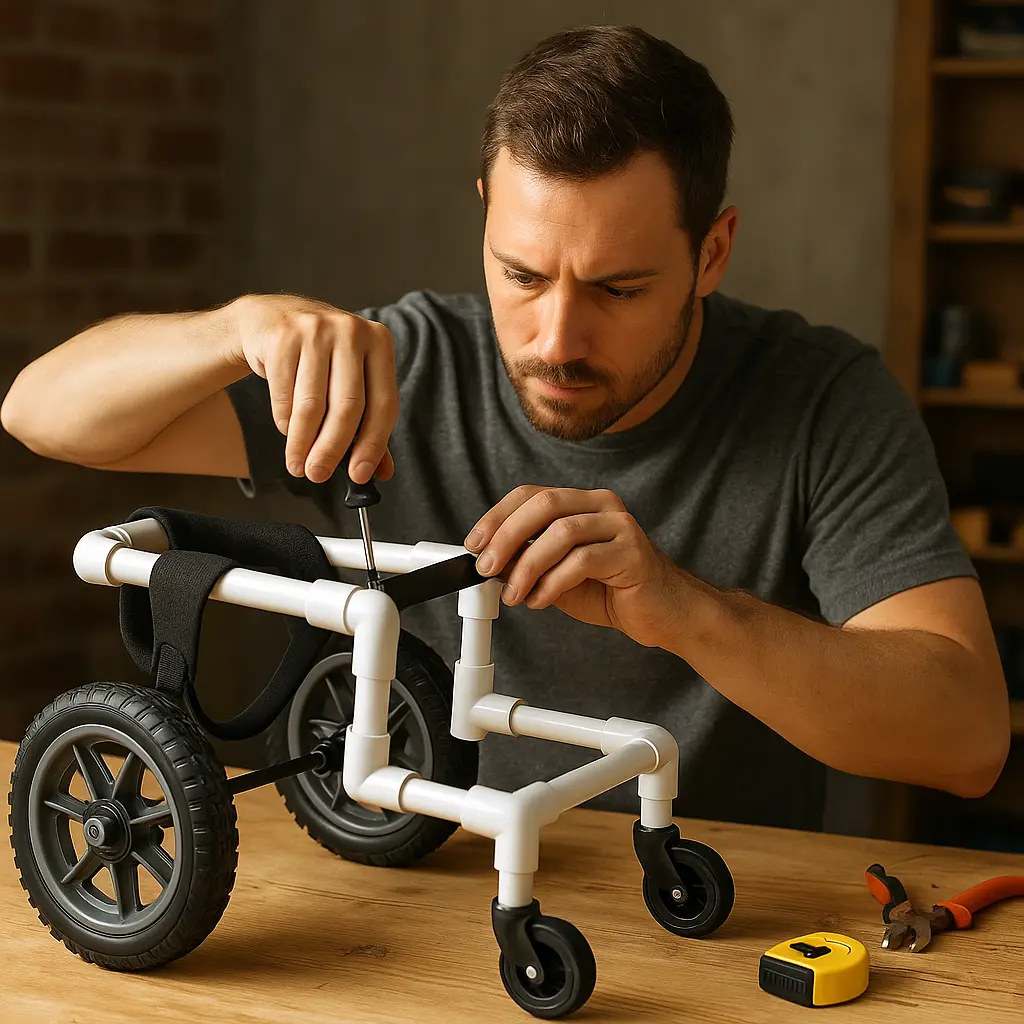
When Max first struggled with his back legs, buying a wheelchair felt expensive. I wondered: Could I build one myself? After some searching, I discovered the answer—yes, you can!
A homemade dog wheelchair can save money and give your dog freedom quickly. I’ll show you how easy it can be, with my own tips and lessons learned.
Can You Really Build Your Own Dog Wheelchair?
Absolutely! DIY dog wheelchairs are becoming popular among pet parents. They’re easy to build with items you can find at your local hardware store. You don’t need special skills, just patience and a little creativity.
When Max needed extra support, our homemade wheelchair helped immediately. Plus, building it felt rewarding. But, there are pros and cons, so let’s explore those first.
DIY Dog Wheelchair: Pros & Cons
| ✅ Pros | ❌ Cons |
| Affordable & budget-friendly | Takes time to build |
| Easy customization for your dog’s needs | May not look as polished as commercial |
| Materials are easy to find locally | Needs adjustments more often |
| Great as a temporary or quick solution | Might not last as long as store-bought |
In short, DIY is perfect if you’re tight on budget or want something custom-made. But if your dog needs long-term help, a commercial wheelchair might be better.
Materials You’ll Need for a DIY Dog Wheelchair
You don’t need fancy items. Here’s what I used to build Max’s wheelchair:
- PVC pipes (light, easy to cut, and strong)
- Pipe connectors (elbows, tees)
- Wheels from old baby strollers or carts
- Soft foam padding or pool noodles
- Strong fabric or straps for harness
- Tape measure, saw, and scissors
- Strong glue or screws for assembly
Most of these items cost less than $50 in total. You might even have some at home already!
Step-by-Step DIY Dog Wheelchair Basics
Building your first wheelchair might seem scary, but it’s actually simple. Here’s a quick guide:
- Measure Your Dog:
- Height: from the ground to their hips.
- Length: from their shoulders to tail-base.
- Width: widest part of their hips.
- Height: from the ground to their hips.
- Cut the PVC Pipes:
- Cut pieces based on your measurements.
- Connect them with elbows and tees to form a frame.
- Cut pieces based on your measurements.
- Add Wheels:
- Attach wheels at the back with screws or strong glue.
- Make sure wheels spin easily.
- Attach wheels at the back with screws or strong glue.
- Add Padding:
- Wrap pipes with soft foam or pool noodles.
- Comfort is key to prevent rubbing.
- Wrap pipes with soft foam or pool noodles.
- Attach Harness or Straps:
- Use soft, strong fabric straps.
- Make sure your dog feels secure and comfortable.
- Use soft, strong fabric straps.
Lessons from My Own DIY Experience
I learned a few important things building Max’s wheelchair:
- Keep Adjusting: You’ll need to adjust as you go. Small changes help your dog feel comfy.
- Patience is Important: It might take a few tries. That’s okay!
- Test Indoors First: Test at home to avoid accidents outdoors.
- Safety First: Check stability and comfort before long walks.
Building Max’s wheelchair felt amazing. It was special seeing him walk again, thanks to something I made myself.
When DIY Isn’t Enough
DIY wheelchairs are great short-term or budget-friendly solutions. But if your dog has long-term mobility issues, brands like Walkin’ Wheels or K9 Carts offer durability and professional support. Their wheelchairs adjust more easily and often last years longer.
DIY vs. Commercial Dog Wheelchairs
| Feature | DIY Wheelchair | Commercial Wheelchair |
| Cost | $20–$50 | $150–$500 |
| Build Time | Few hours | Ready-made or easy setup |
| Adjustability | Needs manual adjustments | Easy adjustments |
| Durability | Short-term (months) | Long-term (years) |
Key Takeaways
- DIY wheelchairs save money and are customizable.
- Easy-to-find items make DIY simple.
- Commercial options offer more comfort and long-term use.
- Either way, seeing your dog happy and mobile again is priceless.
Want More DIY Dog Wheelchair Ideas?
I’d love to share more photos, detailed plans, and tips from other pet parents.
Have you built your own dog wheelchair? Or thinking of giving it a try?
Tell me your experience or ask me questions in the comments below—I’d be happy to help!
Storage, Cleaning & Care Tips for Dog Wheelchairs
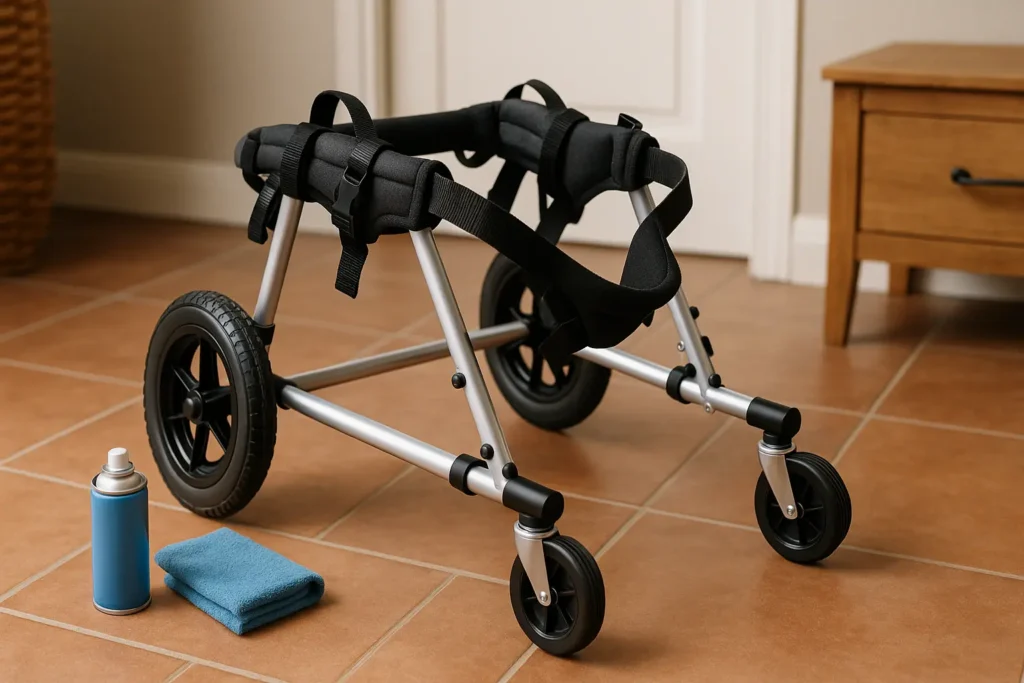
When Max first started using a wheelchair, I quickly learned something important. Keeping his wheelchair clean and properly stored made life easier for both of us.
I’ve made plenty of mistakes along the way, so let me share my tips to help you avoid them. With simple cleaning and storage, your dog’s wheelchair will last longer and stay safe to use.
Why Proper Wheelchair Care Matters
Dog wheelchairs aren’t cheap. Brands like Walkin’ Wheels or K9 Carts are investments in your dog’s health and happiness. Good care means the wheelchair stays comfortable, safe, and durable for many years.
When I first neglected cleaning Max’s wheelchair regularly, it led to rust and wear. But simple daily habits fixed that quickly.
Easy Daily Cleaning Tips
You don’t need fancy tools or lots of time. Here’s how I kept Max’s wheelchair clean each day:
- Quick Wipe Down: Use pet-friendly wipes or a damp cloth to remove dirt or mud.
- Check Wheels Daily: Look for hair or debris wrapped around wheels. It’s quick to remove and prevents bigger problems.
- Inspect Harnesses: Check for dirt or damage. Gentle soap and water cleans fabric easily.
Doing these simple tasks each day only takes five minutes, but it makes a huge difference.
Weekly Deep-Clean Routine
Once a week, set aside 10-15 minutes for a deeper clean. Here’s how I did it with Max’s wheelchair:
- Remove Wheels:
Pop wheels off to clean the axles easily. - Wash with Soap and Water:
Use mild soap or dishwashing liquid. Gently scrub the frame, wheels, and harnesses. - Dry Completely:
Let parts air dry or use a soft towel. Never store parts wet—trust me, rust happens quickly! - Lubricate Moving Parts:
Add a little WD-40 or silicone spray to wheels and joints. This prevents squeaks and keeps movement smooth.
Weekly cleaning was our special ritual, and Max always knew a tasty treat waited afterward!
Safe & Simple Storage Tips
Proper storage helps your wheelchair last much longer. Here’s what worked best for me and Max:
- Indoor Storage:
Store in a dry place like a closet or garage. Avoid humid or damp areas to prevent rust. - Keep Wheelchair Upright:
Storing upright or hung on hooks stops frames from bending or breaking. - Cover If Needed:
Use a cloth or special wheelchair bag. This keeps off dust and pet hair.
Common Mistakes I Learned to Avoid
These small things caused big headaches until I learned better:
- Ignoring Small Issues:
Small cracks or loose screws quickly become big issues. Fix them early. - Storing While Dirty or Wet:
Dirt and moisture cause rust. Clean and dry first—always. - Skipping Regular Checks:
Quick daily checks prevent surprise breakdowns.
Quick Summary: Easy Care Checklist
| Task | Frequency | Time Required |
| Quick Wipe & Inspection | Daily | 5 min |
| Deep Cleaning & Lubricant | Weekly | 15 min |
| Storage Check | Weekly | 2 min |
FAQs on Dog Wheelchair Care
Can I wash my dog’s wheelchair with a hose?
How often should I check wheels for hair or debris?
My wheelchair is squeaky. How can I fix this?
Do dog wheelchairs rust easily?
Can harnesses be machine-washed?
Final Thoughts & Friendly Advice
Taking good care of Max’s wheelchair was one of the best things I did for him. It saved us money, stress, and kept him comfy for years.
Do you have more questions about dog wheelchair care? Or personal stories to share? I’d love to hear them!
Drop your stories or questions below. Your experience might help another pet parent.
Dog Wheelchair Alternatives — What Are Your Other Options?
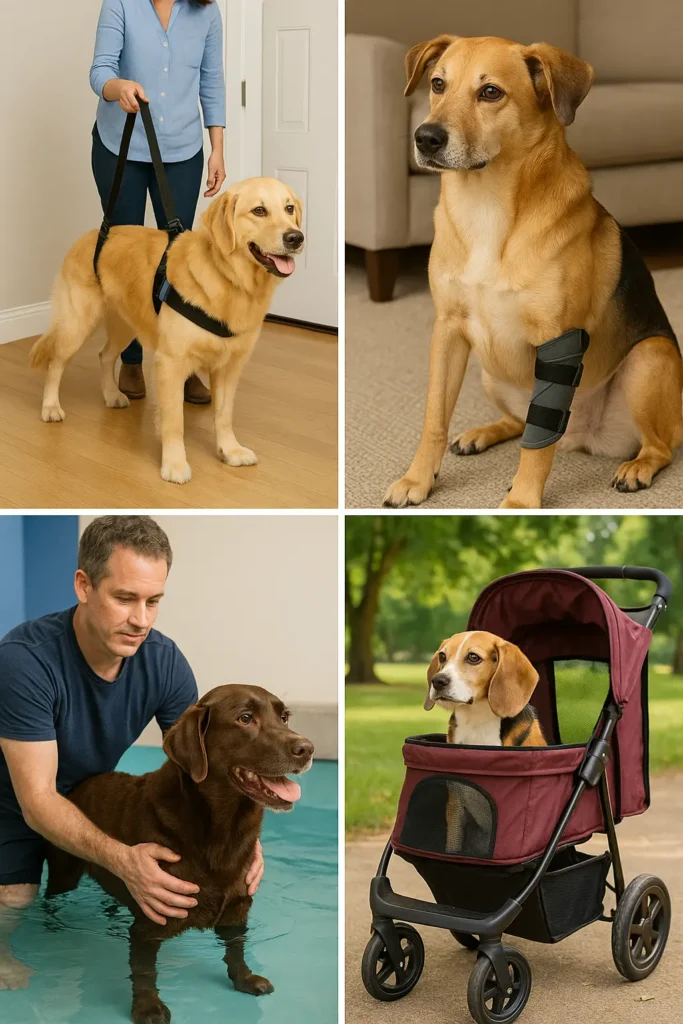
When my dog Max started struggling to walk, a dog wheelchair was the first thing I considered. But I soon discovered it wasn’t the only option. There are many alternatives to dog wheelchairs that might fit your dog’s needs better.
Let me share these options clearly and simply, based on my own experience with Max and insights from other pet parents.
Why Look at Alternatives to Dog Wheelchairs?
A dog wheelchair isn’t always the perfect solution for every dog. They can sometimes be expensive, or your dog might feel uncomfortable using one. Maybe you just need a short-term solution.
Here are some great alternatives to help your dog regain mobility and comfort without using a wheelchair.
Top Alternatives to Dog Wheelchairs
1. Support Harnesses & Slings
Support harnesses and slings are easy, affordable solutions. They help lift your dog’s body gently and safely. You hold the handle, giving your dog the extra support they need to walk or climb stairs.
Pros:
- Affordable and simple to use.
- Great for short-term injuries or minor issues.
Cons:
- Requires you to physically support your dog.
- Not practical for long walks or bigger dogs.
I used a harness with Max when his arthritis first began. It helped us manage stairs safely and comfortably.
2. Orthopedic Dog Braces
Orthopedic braces provide support directly to your dog’s weak joints or legs. They relieve pain and help your dog move better. Many dogs with arthritis or joint injuries benefit greatly from braces.
Pros:
- Customizable and comfortable.
- Allows your dog to walk independently.
Cons:
- Costs can rise if you need custom braces.
- Won’t help with severe paralysis.
Max tried a brace before we moved to a wheelchair. It was excellent for minor issues but wasn’t enough later on.
3. Physical Therapy & Rehab
Physical therapy, massage, and rehab exercises can greatly improve your dog’s strength and mobility. Therapists use gentle exercises, water therapy, or massage to ease pain and boost muscle health.
Pros:
- Natural and safe.
- Improves overall strength and quality of life.
Cons:
- Takes time and commitment.
- Might not fully solve severe mobility problems.
Physical therapy gave Max strength and comfort, especially when combined with other aids like braces or harnesses.
4. Strollers and Wagons
Pet strollers and wagons are fantastic if your dog gets tired quickly. They’re great for long walks or outings when your dog can’t walk long distances.
Pros:
- Comfortable and easy for you and your dog.
- Perfect for older dogs or long outings.
Cons:
- Doesn’t allow independent walking.
- Not helpful for active movement or muscle building.
For park visits or long days out, Max loved relaxing in a wagon. It saved us both stress and energy.
5. DIY Mobility Solutions
If you’re handy, building your own mobility aid is rewarding and budget-friendly. Many pet parents use PVC pipes, foam padding, and wheels to create simple, homemade carts.
Pros:
- Cost-effective and customizable.
- Great short-term solution.
Cons:
- Takes some building skills and patience.
- Usually less durable than store-bought options.
I built Max a simple cart for quick outdoor breaks before buying his Walkin’ Wheels wheelchair. It worked well as a temporary solution.
Quick Comparison of Alternatives:
| Alternative | Best For | Cost | Ease of Use |
| Support Harnesses | Short-term or minor issues | $15–$50 | Very Easy |
| Orthopedic Braces | Joint pain, arthritis | $30–$150 | Moderate |
| Physical Therapy | Strength, minor mobility | Varies widely | Easy |
| Strollers & Wagons | Outings, tired dogs | $50–$200 | Very Easy |
| DIY Solutions | Budget, short-term needs | $20–$60 | Moderate |
Which Option is Best for Your Dog?
Choosing the right alternative depends on your dog’s health, your lifestyle, and your budget. Here’s a quick guide:
- Minor issues or short-term help: Harnesses or DIY carts.
- Joint pain or mild mobility issues: Orthopedic braces and therapy.
- Longer outings or tired dogs: Strollers or wagons.
- Severe or ongoing mobility issues: A professional dog wheelchair (like Walkin’ Wheels or K9 Carts).
FAQs About Dog Wheelchair Alternatives
Are harnesses safe for long-term use?
Can braces really help my dog’s arthritis?
How expensive is physical therapy for dogs?
Do dogs enjoy using strollers or wagons?
Are DIY mobility aids durable enough for daily use?
Final Thoughts & Personal Advice
Exploring dog wheelchair alternatives was a big part of my journey with Max. Each option had its pros and cons, but combining them often worked best.
Remember, there’s no one-size-fits-all solution. Try different things and see what your dog enjoys most. Your dog’s happiness and comfort are the real goals.
I’d love to hear about your experiences or answer any questions you have. Drop your comments or questions below, and let’s chat!
Read Our Latest Article: PetSafe Stay and Play Wireless Fence – Portable Safety for Your Dog



Howdy! I simply would like to give a huge thumbs up for the great info you’ve gotten here on this post. I will likely be coming again to your blog for more soon.